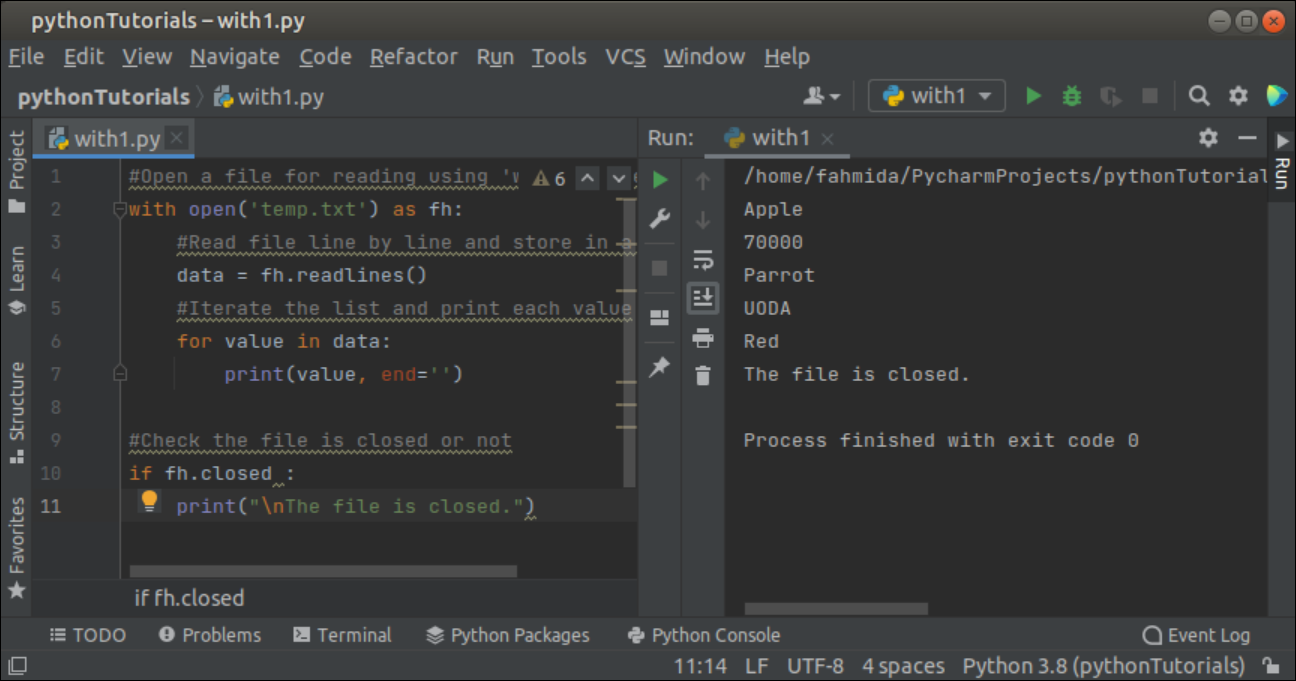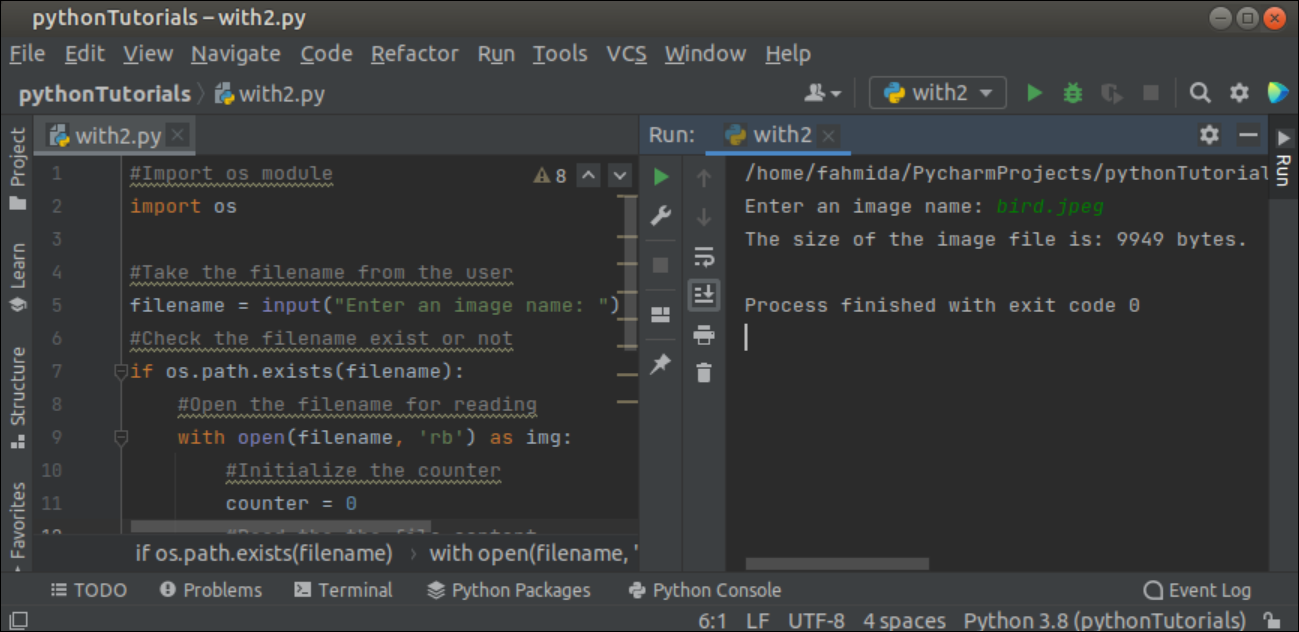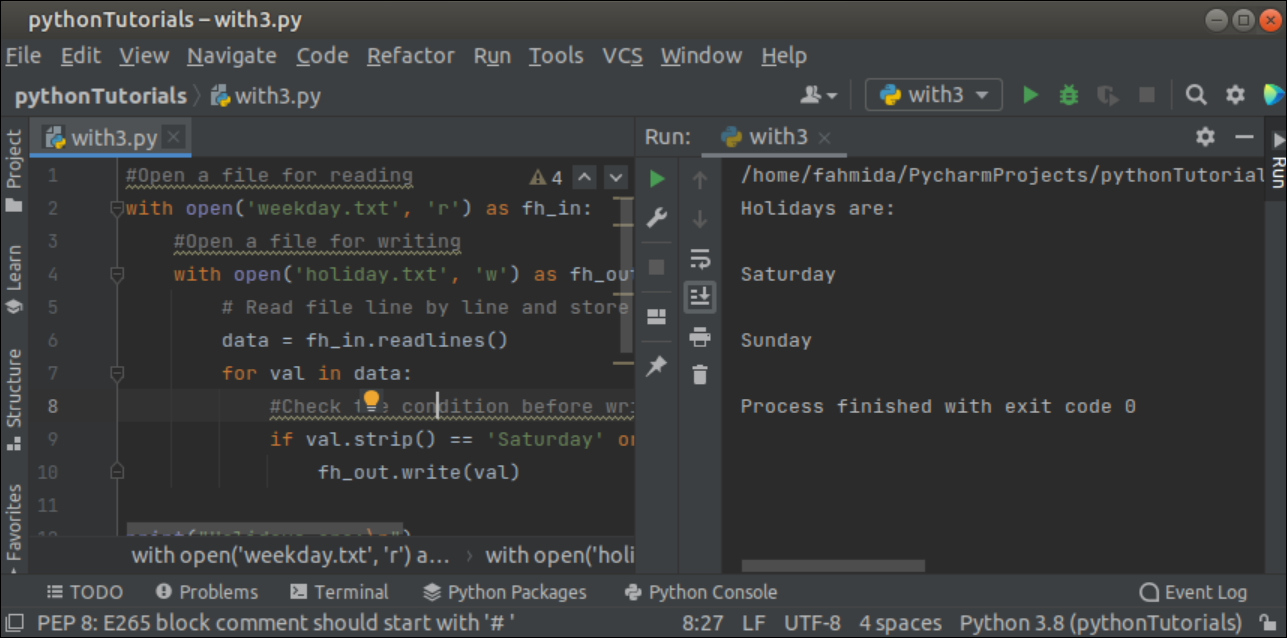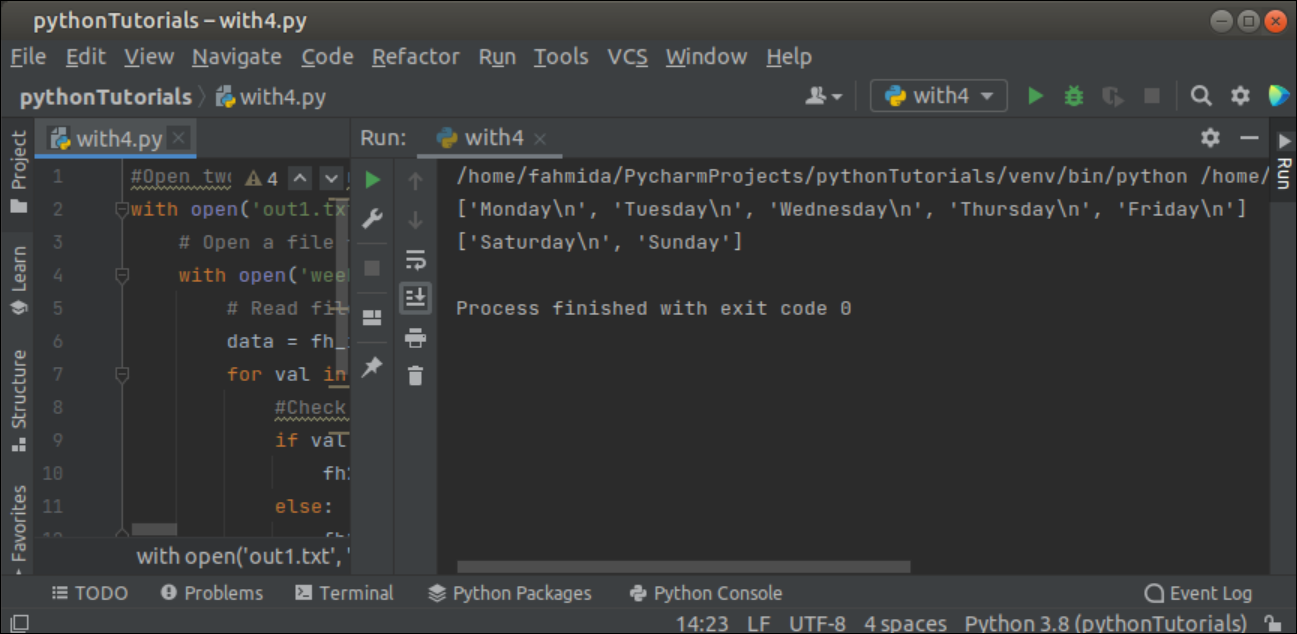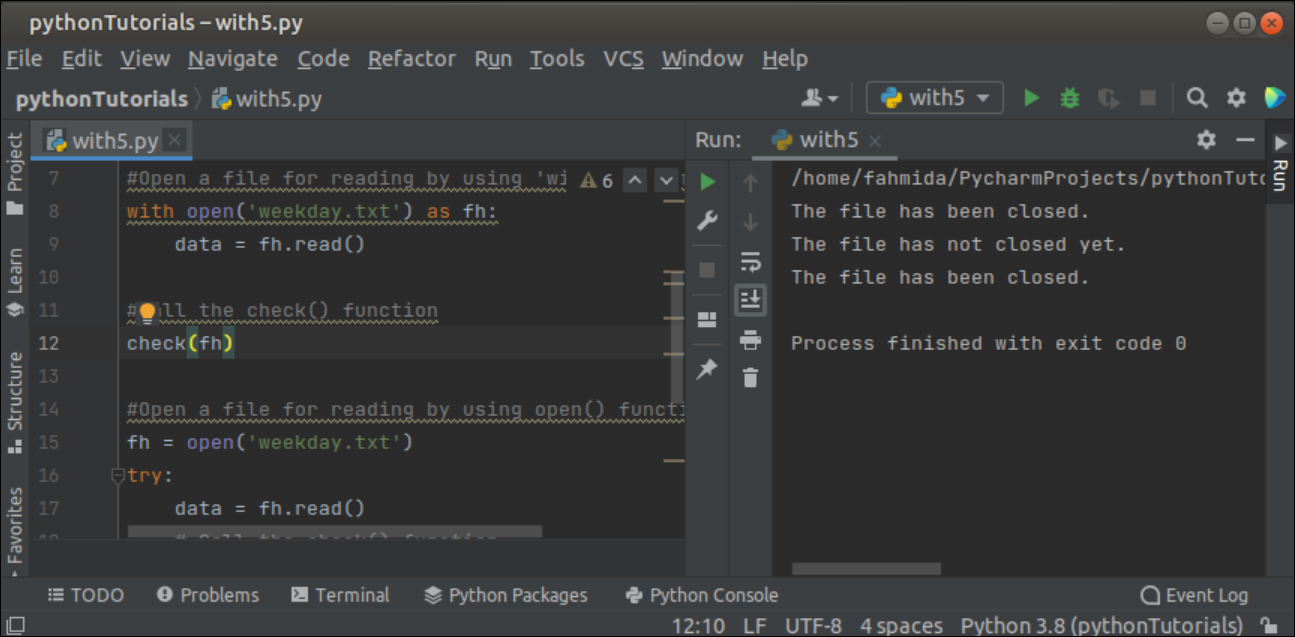- With Open Statement in Python
- The With Statement in Python
- The open() Function in Python
- With Statement Usage with Open() Function in Python
- Conclusion
- Open a File in Python Using the ‘with’ Statement
- with open(file, mode) as file_handler
- Example-1: Read a Text File Using the ‘with’ Statement
- Example-2: Read a Binary File by Using the ‘with’ Statement
- Example-3: Use of the Nested ‘with’ Statements
- Example-4: Open Multiple Files in a Single ‘with’ Statement
- Example-5: Compare ‘with’ Statement with open() Function and open() function
- Conclusion
- About the author
- Fahmida Yesmin
With Open Statement in Python
In Python, you can access a file by using the open() method. However, using the open() method requires you to use the close() method to close the file explicitly. Instead, you can create a context using the with Open statement in Python. In this article, we will discuss how we can automatically open, read, and close a file using the with statement and the open() function in Python.
The With Statement in Python
We use the with statement in Python to create a context. Whatever statements we execute inside the context created using the with statement does not affect the outer environment. The with statement simplifies exception handling by encapsulating common preparation and cleanup tasks. Hence, you can get better syntax and exception handling by using the “With” statement in Python.
The open() Function in Python
We use the open() function to open a file in Python. It takes the filename as its first input argument and the python literals “r”, “w”, “r+”, etc as its second input argument to specify the mode in which the file is opened. After execution, it returns a file pointer.
We can use the file pointer to read from the file or write data to the file. For example, consider that we have the following text file.
In the above file, we have five lines of text, let us open the file using the open() function and read the file contents. For this, we will write the following code in open_example.py file and execute it.
file = open("romeo.txt","r") data = file.read() print("The file contents are:") print (data) file.close() # It's important to close the file when you're done with itOnce we execute the above code, it prints the output of the romeo.txt file as shown below.
When we use the open() statement, we also need to close the file using the close() method. Otherwise, the file may get corrupted. Also, if we write any data to the file and don’t close it, the contents written to the file will not be saved. Hence, it is really important to close the file.
However, we might forget to use the close() statement to close the file. In such a case, we can lose data or even corrupt the file. To avoid this, we can create a context using the with statement and open a file inside it using the open() function. Let us discuss how to use the with statement and the open() function together in Python.
With Statement Usage with Open() Function in Python
As discussed earlier, whatever we do inside the context created using the with statement stays inside the context. Hence, we can also use the with statement with the open() function in Python to open a file, perform operations on it, and close it. The syntax for using the with statement is as follows.
with open(filename, mode) as myFile: //read from the file // write to the file.In the above syntax, the file is opened, and the file pointer is assigned to the myFile variable. Then, we can perform read and write operations on the file using the myFile object. When all the statements inside the with block are executed, the file is automatically closed.
For example, we can rewrite the code used in the previous example using the with statement and the open() function as shown below.
with open("romeo.txt","r") as file: data=file.read() print("The file contents are:") print(data) The above code works in the same manner as the previous code without the need to use the close() method. Hence, combining the with statement and the open() function in Python helps us read and write to the file without being worried about closing it.
In the above code, you can observe that we have opened the romeo.txt file using the with open statement. The statement returns a file pointer that is assigned to the variable “file”. Now, we can perform any operation on the file object inside the context of the with statement. Once all the statements are executed and the execution reaches the end of the with context block, the file is automatically closed by the Python interpreter.
Also, if the program runs into any exception inside the with block, the with open context in Python closes the file before terminating the program. In this way, the data inside the file remains safe even if the program is terminated abruptly. Notice, that we didn’t have to write “file.close()”. That will automatically be called.
Conclusion
In this article, we have discussed how you can use the with open statement instead of the open()
method to open a file in Python. To learn more about Python programming, you can read this article on string manipulation in Python. You might also like this article on Python if else shorthand.
Open a File in Python Using the ‘with’ Statement
When it requires storing some data permanently for the programming purpose, then a file is used to do this task. Generally, the open() function is used in Python to open a file for reading and writing. The open() method returns an object to work with the file. When any file is opened by the open() function, then it requires to close the file. Using the ‘with’ statement is the alternative way of opening a file in Python. It is better than the open() function and it helps to manage the resource more efficiently because it ensures that the opened resource is closed by closing the file automatically after completing the task. The file opening error can be handled also without try-except block using the ‘with’ statement.
The syntax of the ‘with’ statement to open a file for reading and writing has shown below.
with open(file, mode) as file_handler
- The first argument is mandatory and contains the filename.
- The second argument is optional which is used to define the mode for opening the file to read or write or append.
Example-1: Read a Text File Using the ‘with’ Statement
Create a Python file with the following script that will open a text file by using the ‘with’ statement. Here, the temp.txt file will be opened for reading and the readlines() function will be used to read the content of the file and store it into a list variable. Next, the for loop will iterate the list values and print the file content. The closed attribute will be True after reading the content of the file.
#Open a file for reading using ‘with’ statement
with open ( ‘sales.txt’ ) as fh:
#Read file line by line and store in a list
data = fh. readlines ( )
#Iterate the list and print each value
for value in data:
print ( value , end = » )
#Check the file is closed or not
if fh. closed :
print ( » \n The file is closed.» )
The following output will appear after executing the above script if the sales.txt file exists in the current location. The output shows that the file is closed automatically after completing the reading of the file.
Example-2: Read a Binary File by Using the ‘with’ Statement
Create a Python file with the following script that will open a binary file for reading and calculate the size of the file in bytes. The filename will be taken from the user.
#Import os module
import os
#Take the filename from the user
filename = input ( «Enter an image name: » )
#Check the filename exist or not
if os . path . exists ( filename ) :
#Open the filename for reading
with open ( filename , ‘rb’ ) as img:
#Initialize the counter
counter = 0
#Read the the file content
while img. read ( True ) :
#Increment the counter
counter + = 1
print ( «The size of the image file is: %d bytes.» %counter )
else :
print ( «the file does not exist.» )
The following similar output will appear after executing the above script if the bird.jpeg file exists in the current location. The output shows that the size of the file is 9946 bytes.
Example-3: Use of the Nested ‘with’ Statements
Create a Python file with the following script that will open a file for reading and open another file for writing by using the nested ‘with’ statements. The first ‘with’ statement is used to open the weekday.txt file for reading that is created before. The second ‘with’ statement is used to open the holiday.txt file for writing the specific content from the weekday.txt file.
#Open a file for reading
with open ( ‘weekday.txt’ , ‘r’ ) as fh_in:
#Open a file for writing
with open ( ‘holiday.txt’ , ‘w’ ) as fh_out:
# Read file line by line and store in a list
data = fh_in. readlines ( )
for val in data:
#Check the condition before writing
if val. strip ( ) == ‘Saturday’ or val. strip ( ) == ‘Sunday’ :
fh_out. write ( val )
print ( «Holidays are: \n » )
#Opening the newly created file for reading
with open ( ‘holiday.txt’ , ‘r’ ) as fh:
# Read file line by line and store in a list
data = fh. readlines ( )
for val in data:
print ( val )
The following output will appear after executing the above script.
Example-4: Open Multiple Files in a Single ‘with’ Statement
Create a Python file with the following script that will open two files for writing by using a single ‘with’ statement. The script will open the weekday.txt file for reading and some specific content of this file will be written in the out1.txt file and out2.txt file. Next, both newly written files will be opened for reading and the content of these files will be printed.
#Open two files for writing
with open ( ‘out1.txt’ , ‘w’ ) as fh1 , open ( ‘out2.txt’ , ‘w’ ) as fh2:
# Open a file for reading
with open ( ‘weekday.txt’ , ‘r’ ) as fh_in:
# Read file line by line and store in a list
data = fh_in. readlines ( )
for val in data:
#Check the condition before writing
if val. strip ( ) == ‘Saturday’ or val. strip ( ) == ‘Sunday’ :
fh2. write ( val )
else :
fh1. write ( val )
#Open two newly written files for reading
with open ( ‘out1.txt’ , ‘r’ ) as fh1 , open ( ‘out2.txt’ , ‘r’ ) as fh2:
print ( fh1. readlines ( ) )
print ( fh2. readlines ( ) )
The following output will appear after executing the above script.
Example-5: Compare ‘with’ Statement with open() Function and open() function
Create a Python file with the following script that will open the same file named weekday.txt by using the ‘with’ statement and open() function. It has been shown in the previous example that the file is closed automatically after reading or writing the content, if it is opened by using the ‘with’ statement. But the file requires to close by using the close() function, if the file is opened by using the open() function that was shown by using the try-finally block in this script.
# Declare a function to check the file is closed or not
def check ( f ) :
if f. closed :
print ( «The file has been closed.» )
else :
print ( «The file has not closed yet.» )
# Open a file for reading by using the ‘with’ statement
with open ( ‘weekday.txt’ ) as fh:
data = fh. read ( )
# Call the check() function
check ( fh )
# Open a file for reading by using open() function
fh = open ( ‘weekday.txt’ )
try :
data = fh. read ( )
# Call the check() function
check ( fh )
finally :
fh. close ( )
# Call the check() function
check ( fh )
The following output will appear after executing the above script.
Conclusion
Different uses of the ‘with’ statement to open any file for reading or writing have been shown in this tutorial by using simple examples that will help the Python users to know the purposes of using the ‘with’ statement in Python.
About the author
Fahmida Yesmin
I am a trainer of web programming courses. I like to write article or tutorial on various IT topics. I have a YouTube channel where many types of tutorials based on Ubuntu, Windows, Word, Excel, WordPress, Magento, Laravel etc. are published: Tutorials4u Help.




